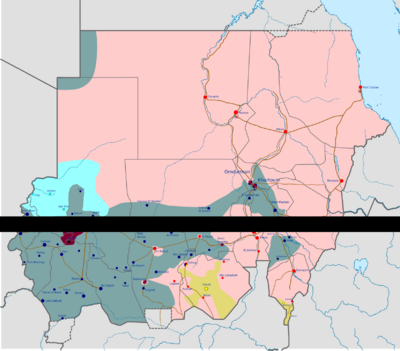Sudanese civil war (2023–present) facts for kids
Quick facts for kids Sudanese civil war (2023–present) |
||||||||||
|---|---|---|---|---|---|---|---|---|---|---|
| Part of the Sudanese Civil Wars | ||||||||||
 Military situation as of 22 March 2025 Controlled by Sudanese Armed Forces and allies Controlled by Rapid Support Forces Controlled by SPLM-N (al-Hilu) Controlled by SLM (al-Nur) |
||||||||||
|
||||||||||
| Belligerents | ||||||||||
|
Government of Peace and Unity (from February 2025)
|
|
||||||||
| Commanders and leaders | ||||||||||
|
|
|
||||||||
| Strength | ||||||||||
| ~300,000 | ~100,000 | Unknown | ||||||||
| Casualties and losses | ||||||||||
|
||||||||||
A civil war between two major rival factions of the military government of Sudan began during Ramadan on 15 April 2023. The two opponent factions consist of the Sudanese Armed Forces (SAF) under Abdel Fattah al-Burhan and the paramilitary Rapid Support Forces (RSF) and its allies (collectively the Janjaweed coalition) under the Janjaweed leader Hemedti. Minor factions have also participated in the fighting, allying with either major combatant or remaining opposed to both; these include the Darfur Joint Protection Force; the SLM (al-Nur) under Abdul Wahid al-Nur; and the SPLM-N under Abdelaziz al-Hilu. Fighting has been concentrated around the capital city of Khartoum (the largest and initial battle of the war) and the Darfur region.
As of 14 November 2024, at least 61,000 people had been killed in Khartoum State alone, of which 26,000 were a direct result of the violence. As of 5 February 2025, over 8.8 million were internally displaced and more than 3.5 million others had fled the country as refugees, and many civilians in Darfur have been reported dead as part of the Masalit massacres.
The war began with attacks by the RSF on government sites as airstrikes, artillery, and gunfire were reported across Sudan. The cities of Khartoum and Omdurman were divided between the two warring factions, with al-Burhan relocating his government to Port Sudan as RSF forces captured most of Khartoum's government buildings. Attempts by international powers to negotiate a ceasefire culminated in the Treaty of Jeddah in May 2023, which failed to stop the fighting and was ultimately abandoned.
Over the next few months, a stalemate occurred, during which the two sides were joined by rebel groups who had previously fought against Sudan's government. By mid-November, the Minni Minnawi and Mustafa Tambour factions of the Sudan Liberation Movement officially joined the war in support of the SAF, alongside the Justice and Equality Movement (JEM). In contrast, the Tamazuj movement joined forces with the RSF, while the Abdelaziz al-Hilu faction of the Sudan People's Liberation Movement–North attacked SAF positions in the south of the country.
In October 2023, momentum began to swing toward the RSF, as the paramilitary defeated army forces in Darfur and made gains in Khartoum State, Kordofan, and Gezira State. Since February 2024, the SAF has made gains in Omdurman. Since June 2024, the RSF has made gains in Sennar State. Further negotiations between the warring sides have produced no significant results, while many countries have provided military or political support for either al-Burhan or Hemedti. As of February 2025, the SAF has made notable gains in Khartoum and Khartoum North (alternatively referred to as Bahri).
In August 2024, the Integrated Food Security Phase Classification (IPC) Famine Review Committee (FRC) confirmed famine conditions in parts of North Darfur.
In March 2025, the SAF retook the Presidential Palace in Khartoum from the RSF.
Humanitarian impact
Humanitarian crisis
The humanitarian crisis following the fighting was further exacerbated by the violence occurring during a period of high temperatures, and drought starting during the fasting month of Ramadan. Civilians were unable to venture outside of their homes to obtain food and supplies for fear of getting caught in the crossfire. A doctors' group said that hospitals remained understaffed and were running low on supplies as wounded people streamed in. The World Health Organization (WHO) recorded around 26 attacks on healthcare facilities, some of which resulted in casualties among medical workers and civilians. In August 2024 cholera was declared an epidemic in the country and as of 8 September 2024[update], there were 5,692 cases of cholera including 185 deaths.
In April 2023, the United Nations reported that shortages of basic goods, such as food, water, medicines and fuel have become "extremely acute".
In September 2023, the UN Office for the Coordination of Humanitarian Affairs said that 1,200 children had died from disease outbreaks in refugee camps in White Nile State since May. By 2024, the war's economic costs had surpassed all prior armed conflicts since Sudanese independence in 1956 due to extensive destruction of infrastructure, particularly in urban areas such as the capital city of Khartoum.
The dramatic decrease in agricultural activity ("cereal production in 2023 was nearly halved") caused increases in food prices, and the conflict led to infrequent aid convoys.
Famine
By February 2025, famine had taken hold in at least five regions, with over 600,000 people at risk of starvation. Cholera outbreaks have surged due to the collapse of Sudan's healthcare infrastructure.
Refugees
As of February 2025, over 12.3 million residents of Sudan have been displaced due to the fighting. The United Nations said that the conflict had produced more than 8.8 million internally displaced persons (IDPs), while more than 3.5 million had fled the country. This makes Sudan the largest host of IDPs globally.
See also
 In Spanish: Guerra civil sudanesa (2023-presente) para niños
In Spanish: Guerra civil sudanesa (2023-presente) para niños
- Sudanese Civil War, an index of at least three separate conflicts in Sudan
- Human rights in Sudan
- War in Darfur
- Darfur genocide
- 2021 Sudan coup d'état
- Timeline of the Sudanese civil war (2023)
- Timeline of the Sudanese civil war (2024)
- Genocide of Indigenous peoples § Darfur
- Genocides in history (21st century) § Darfur
- List of civil wars
- List of conflicts in Africa
- List of ethnic cleansing campaigns
- List of genocides
- List of ongoing armed conflicts
- List of wars: 2003–present
- Sudanese National Forces Coordination


